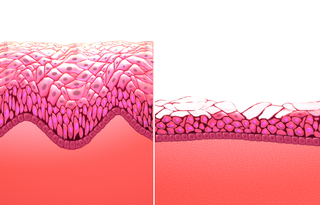Hot flashes are a form of flushing due to reduced levels of estradiol. Hot flashes are a symptom which may have several other causes, but which is often caused by the changing hormone levels that are characteristic of menopause. They are typically experienced as a feeling of intense heat with sweating and rapid heartbeat, and may typically last from 2 to 30 minutes for each occurrence.
Breast pain is the symptom of discomfort in the breast. Pain that involves both breasts and which occurs repeatedly before the menstrual period is generally not serious. Pain that involves only one part of a breast is more concerning. It is particular concerning if a hard mass or nipple discharge is also present.

Norethisterone acetate (NETA), also known as norethindrone acetate and sold under the brand name Primolut-Nor among others, is a progestin medication which is used in birth control pills, menopausal hormone therapy, and for the treatment of gynecological disorders. The medication available in low-dose and high-dose formulations and is used alone or in combination with an estrogen. It is taken by mouth.

Estropipate, also known as piperazine estrone sulfate and sold under the brand names Harmogen, Improvera, Ogen, Ortho-Est, and Sulestrex among others, is an estrogen medication which is used mainly in menopausal hormone therapy in the treatment of menopausal symptoms. It is a salt of estrone sulfate and piperazine, and is transformed into estrone and estradiol in the body. It is taken by mouth.

Dienestrol, also known as dienoestrol (BAN), is a synthetic nonsteroidal estrogen of the stilbestrol group which is or was used to treat menopausal symptoms in the United States and Europe. It has been studied for use by rectal administration in the treatment of prostate cancer in men as well. The medication was introduced in the U.S. in 1947 by Schering as Synestrol and in France in 1948 as Cycladiene. Dienestrol is a close analogue of diethylstilbestrol. It has approximately 223% and 404% of the affinity of estradiol at the ERα and ERβ, respectively.
Aggressive lymphoma is a type of lymphoma that grows and spreads quickly, and has severe symptoms. It is seen frequently in patients who are HIV-positive. Also called intermediate-grade lymphoma and high-grade lymphoma.
Biochemical recurrence is a rise in the blood level of prostate-specific antigen (PSA) in prostate cancer patients after treatment with surgery or radiation. Biochemical recurrence may occur in patients who do not have symptoms. It may mean that the cancer has come back. Also called PSA failure and biochemical relapse.
Choroid plexus tumors are a rare type of cancer that occur from the brain tissue called choroid plexus of the brain. These tumors usually occur in children younger than 2 years and are classified according to the WHO classification of the tumors of the central nervous system:
The Brief Pain Inventory is a medical questionnaire used to measure pain, developed by the Pain Research Group of the WHO Collaborating Centre for Symptom Evaluation in Cancer Care.
Clear-cell adenocarcinoma (CCA) of the vagina or cervix is a rare adenocarcinoma often linked to prenatal exposure to diethylstilbestrol (DES), a drug which was prescribed in high-risk pregnancy.
Chronic phase chronic myelogenous leukemia is a phase of chronic myelogenous leukemia in which 5% or fewer of the cells in the blood and bone marrow are blast cells. This phase may last from several months to several years, and there may be no symptoms of leukemia.
Idiopathic pneumonia syndrome is a set of pneumonia-like symptoms that occur with no sign of infection in the lung. Idiopathic pneumonia syndrome is a serious condition that can occur after a stem cell transplant. It occurs between 2.2 and 15 percent of hematopoietic stem cell transplants. The incubation period ranges between 4 to 106 days, but mostly is about 22 days from transplant.

An inverted papilloma is a type of tumor in which surface epithelial cells grow downward into the underlying supportive tissue. It may occur in the nose and/or sinuses or in the urinary tract. When it occurs in the nose or sinuses, it may cause symptoms similar to those caused by sinusitis, such as nasal congestion. When it occurs in the urinary tract, it may cause blood in the urine.
Plexopathy is a disorder affecting a network of nerves, blood vessels, or lymph vessels. The region of nerves it affects are at the brachial or lumbosacral plexus. Symptoms include pain, loss of motor control, and sensory deficits.
A nicotine nasal spray is a nasal spray that contains a small dose of nicotine, which enters the blood by being absorbed through the lining of the nose. This helps stop nicotine cravings and relieves symptoms that occur when a person is trying to quit smoking. A prescription is needed for nicotine nasal spray in many countries. In the United Kingdom, it can be purchased in a pharmacy as an Over-the-counter drug.
Hormone replacement therapy (HRT), also known as menopausal hormone therapy (MHT) or postmenopausal hormone therapy, is a form of hormone therapy used to treat symptoms associated with female menopause. These symptoms can include hot flashes, vaginal atrophy, accelerated skin aging, vaginal dryness, decreased muscle mass, sexual dysfunction, and bone loss. They are in large part related to the diminished levels of sex hormones that occur during menopause.

Atrophic vaginitis is inflammation of the vagina as a result of tissue thinning due to not enough estrogen. Symptoms may include pain with sex, vaginal itchiness or dryness, and an urge to urinate or burning with urination. It generally does not resolve without ongoing treatment. Complications may include urinary tract infections.
Conjugated estrogens/medroxyprogesterone acetate (CEs/MPA), sold under the brand names Prempro and Premphase, is a combination product of conjugated estrogens (Premarin), an estrogen, and medroxyprogesterone acetate (Provera), a progestogen, which is used in menopausal hormone therapy for the treatment of menopausal symptoms.

Estradiol/medroxyprogesterone acetate (E2/MPA), sold under the brand names Indivina and Tridestra among others, is a combination product of estradiol, an estrogen, and medroxyprogesterone acetate, a progestogen, which is used in menopausal hormone therapy for the treatment of menopausal symptoms. It is taken by mouth.








